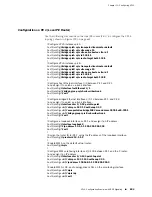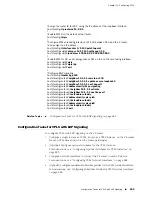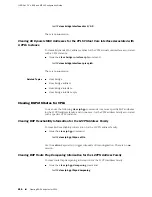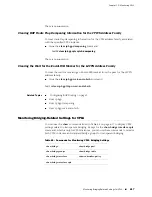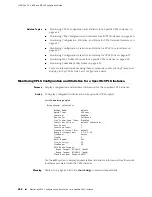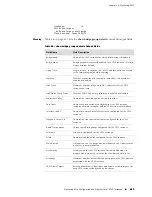
5.
Configure a loopback interface to be associated with the targeted LDP neighbor,
and assign a router ID that uses the IP address of the loopback interface.
For instructions, see “Configuring the Loopback Interface and Router ID for VPLS”
on page 598.
6.
Configure MPLS LSPs to connect local and remote PE routers.
For instructions, see “Configuring MPLS LSPs for VPLS” on page 599.
7.
Set up LDP signaling for this VPLS instance to establish targeted sessions to the
remote PE neighbors configured at the edge of the MPLS core network.
8.
Configure an interior gateway protocol (IGP), such as Open Shortest Path First
(OSPF) or Intermediate System–to–Intermediate System (IS-IS), to enable routing
within the core network.
Related Topics
■
Configuring VPLS Instances with LDP Signaling on page 606
■
Configuring Optional Attributes for VPLS Instances on page 593
■
Configuring VPLS Network Interfaces on page 594
■
Configuring Subscriber Policies for VPLS Network Interfaces on page 595
■
Configuring the Loopback Interface and Router ID for VPLS on page 598
■
Configuring MPLS LSPs for VPLS on page 599
■
Configuring LDP Signaling for VPLS on page 607
■
Configuring Routing in the Core Network for VPLS on page 608
■
See VPLS Configuration Example with LDP Signaling on page 608 for a detailed
sample configuration.
Configuring VPLS Instances with LDP Signaling
As is the case with BGP signaling, when you use LDP signaling you must configure
a VPLS instance for each VPLS domain in which the router participates. Unlike BGP
signaling, however, configuring a VPLS instance for LDP signaling requires only that
you specify the transport virtual router for this instance by issuing the
bridge vpls
transport-virtual-router
command.
To configure a basic VPLS instance with LDP signaling on the PE router:
■
From Global Configuration mode, create the VPLS instance by specifying the
transport virtual router for this instance.
host1(config)#
bridge customer3 vpls transport-virtual-router vr1
The transport virtual router specifies the name of the virtual router on which the
LDP instance that signals reachability for this VPLS instance is configured. If the
bridge group you specify (customer3 in this example) already exists on the router,
issuing this command causes the bridge group to become a VPLS instance.
606
■
Configuring VPLS Instances with LDP Signaling
JUNOSe 11.1.x BGP and MPLS Configuration Guide
Summary of Contents for BGP
Page 6: ...vi ...
Page 8: ...viii JUNOSe 11 1 x BGP and MPLS Configuration Guide ...
Page 37: ...Part 1 Border Gateway Protocol Configuring BGP Routing on page 3 Border Gateway Protocol 1 ...
Page 38: ...2 Border Gateway Protocol JUNOSe 11 1 x BGP and MPLS Configuration Guide ...
Page 234: ...198 Monitoring BGP JUNOSe 11 1 x BGP and MPLS Configuration Guide ...
Page 236: ...200 Multiprotocol Layer Switching JUNOSe 11 1 x BGP and MPLS Configuration Guide ...
Page 542: ...506 Monitoring BGP MPLS VPNs JUNOSe 11 1 x BGP and MPLS Configuration Guide ...
Page 544: ...508 Layer 2 Services Over MPLS JUNOSe 11 1 x BGP and MPLS Configuration Guide ...
Page 610: ...574 Virtual Private LAN Service JUNOSe 11 1 x BGP and MPLS Configuration Guide ...
Page 624: ...588 VPLS References JUNOSe 11 1 x BGP and MPLS Configuration Guide ...
Page 680: ...644 Virtual Private Wire Service JUNOSe 11 1 x BGP and MPLS Configuration Guide ...
Page 724: ...688 Monitoring MPLS Forwarding Table for VPWS JUNOSe 11 1 x BGP and MPLS Configuration Guide ...
Page 725: ...Part 6 Index Index on page 691 Index 689 ...
Page 726: ...690 Index JUNOSe 11 1 x BGP and MPLS Configuration Guide ...












